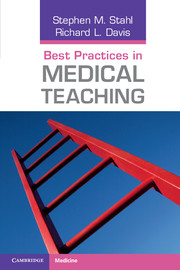Book contents
- Frontmatter
- Contents
- Preface
- About the authors
- Foreword
- Acknowledgments
- Introduction
- 1 Applying the principles of adult education to the designing of medical presentations
- 2 Using audience learning psychology to advantage in designing and delivering medical presentations
- 3 Executing the principles of adult learning in medical presentations
- 4 Measuring outcomes and ensuring success
- 5 Using interval learning in a comprehensive medical educational program
- References
- Progress check answer keys
- Progress check answer sheets
- Index
2 - Using audience learning psychology to advantage in designing and delivering medical presentations
Published online by Cambridge University Press: 05 August 2011
- Frontmatter
- Contents
- Preface
- About the authors
- Foreword
- Acknowledgments
- Introduction
- 1 Applying the principles of adult education to the designing of medical presentations
- 2 Using audience learning psychology to advantage in designing and delivering medical presentations
- 3 Executing the principles of adult learning in medical presentations
- 4 Measuring outcomes and ensuring success
- 5 Using interval learning in a comprehensive medical educational program
- References
- Progress check answer keys
- Progress check answer sheets
- Index
Summary
Chapter overview
Chapter 2 examines those characteristics that all audiences have in common, starting from the moment just before people walk into the meeting room. Emphasis is given to the characteristics that are most common in members of a medical audience.
The first section explains how to settle tensions in the learning environment. Audiences experience four tensions that have the potential to distract at least some of them from an instructor's message: discomfort in the room, tensions with the other learners, unfamiliarity with the instructor, and tension with the material and the process of the presentation. Instructors who are aware of these tensions can relieve them, thereby making audiences more receptive to instruction.
Even after audience members settle down, they will be able to pay attention only for a limited amount of time. The next section will discuss ways to accommodate the attention span of audience members to ensure they are highly interested and fully focused throughout a presentation.
Each audience member's receptiveness to a presentation, or to any given part of a presentation, depends in part on his or her learning style. Understanding and accommodating the four learning styles – visual, auditory, reading/writing, and kinesthetic/tactile – can help an instructor develop and implement a presentation that is more effective for a greater portion of the audience.
Different learners will want to use newly acquired information in different ways – either for problem solving (convergent thinking) or for idea generating (divergent thinking).
Information
- Type
- Chapter
- Information
- Best Practices in Medical Teaching , pp. 61 - 94Publisher: Cambridge University PressPrint publication year: 2011
